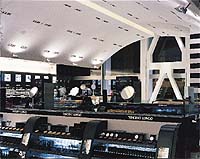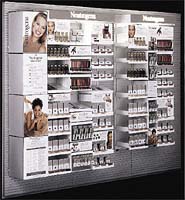At the forefront of the universal and open sell fixture movement in cosmetics is Sephora, which says, “Our image is our fixture design.” The French chain has rolled out in more than 50 U.S. locations, including San Francisco (shown). Photography: John Sutton, Pt. San Quentin, Calif.
As French cosmetics purveyor Sephora has cut its way across the U.S. retail landscape, it has challenged many cosmetics merchandising conventions. Absent are the vendor-supplied fixture pieces that broadcast the brands'names. Gone, too, are those ubiquitous cosmetics islands, with customers on the outside, vying for the salesperson's attention. Instead, the Sephora stores are visually crisp, uncluttered, uniform, universal and generic. All the products — for all the vendors — sit side by side on the same shelving units. Practically everything is merchandised as help-yourself open sell. The only brand that dominates the environment, in fact, is Sephora. This is Sephora's formula for success. As other retailers try to copy Sephora's recipe, while re-energizing their own brand names, there's a movement toward universal fixturing and open sell. “We're definitely a pace-setter,” says Barbara Emerson, director of store planning and design for Sephora S.A.A.P., San Francisco. Is everyone trying to be Sephora? Emerson chuckles: “Occasionally. But less successfully.”
Brand Aid
“Absolutely, there is a universal fixturing trend,” says Judy Bell, corporate manager of visual merchandising for Target Stores. While Bell will not comment on Target's strategy, she has noticed many retailers going forward with uniform fixturing, which she says strengthens a store's cachet. “I always thought it was too distracting to have too much vendor presence,” Bell says. “A store loses its identity that way.” It's interesting, though, that the universal fixturing trend has become a hot news item in the one department typically thought to be most vendor-identity-conscious — cosmetics. It's a prime real estate area with a lot of sales volume at stake. But then again, look how Sephora's non-conformity (by conformity) has paid off. The European import debuted in the U.S. about two years ago and quickly went bi-coastal with 50 stores (in addition to more than 140 locations worldwide). Whether shopping in Livorno or Las Vegas, there's no mistaking the zebra-colored store with the lacquer-red perfume organ — the centrally located circular booth that entices customers with several hundred scents.
Although Neutrogena Cosmetics has invested in new merchandising systems of its own (like this one designed by Display Systems, Maspeth, N.Y.), the vendor has also pledged to work with retailers who have adopted universal fixtures to “co-exist with equity.” Photograph courtesy of Display Systems, Maspeth, N.Y.
“Our image is our fixture design,” says Emerson. The now-famous black powdercoat system with black or white colored glass “belongs exclusively to us and is not altered by the cosmetic brands.” In addition to bolstering the store as a brand, Emerson says Sephora has found it a “democratic” way to present merchandise. “We've given young brands — such as Hard Candy, Club Monaco and Benefits — an opportunity to be featured equally.” Nice for the young brands. But what about the Lancômes, Cliniques and Estée Lauders? It's unlikely that they'd agree to a level playing field in a department store setting. As John O'Brien, director of planning for Federated Department Stores, says, “There's always going to be the 'big three'that have their own fixturing and territory.” However, he adds, the newer, trendier vendors can be easily incorporated into the department store sales floor thanks to generic fixturing. There's something Utopian about universal fixturing. It's a great brand equalizer. But while some department store groups (like Federated) are exploring the revolution, others (like Saks Inc.) are still hewing to the caste system, classifying universal fixturing as a brand-identity tool more suitable for mass merchants. “The universal fixturing trend has all stores evaluating where they need to be as far as the cosmetics vendors go,” says Ken Poston, Saks vp of store planning and design. But Poston notes that going all-universal isn't a sound economic decision for every retailer. “The problem is, when you make a vendor use a generic fixture, that vendor usually doesn't pay a percentage of the costs. That places the financial burden wholly on the retailer.” Poston says he doesn't know how much success department stores will have using all-generic cosmetics fixtures. While stores in the Saks Inc. organization do have some generic fixturing, he adds, “at this point, we're not pursuing it for all our vendors.”
Advertisement


 Photo Gallery1 week ago
Photo Gallery1 week ago
 Headlines7 days ago
Headlines7 days ago
 Headlines1 week ago
Headlines1 week ago
 Headlines2 weeks ago
Headlines2 weeks ago
 Headlines2 days ago
Headlines2 days ago
 Headlines1 week ago
Headlines1 week ago
 Designer Dozen2 weeks ago
Designer Dozen2 weeks ago
 Designer Dozen5 days ago
Designer Dozen5 days ago
















